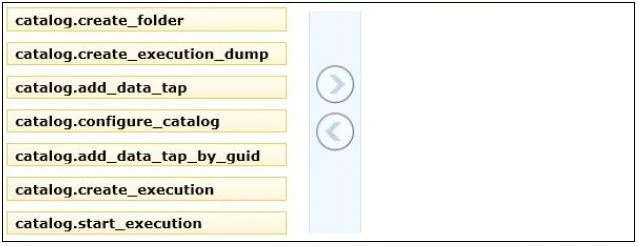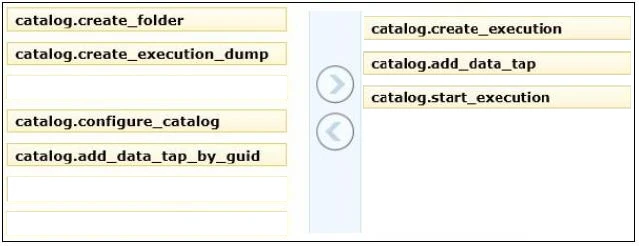Question 6 of 218
You maintain a SQL Server Integration Services (SSIS) package. The package was developed by using SQL Server 2008 Business Intelligence Development
Studio (BIDS).
The package includes custom scripts that must be upgraded.
You need to upgrade the package to SQL Server 2012.
Which tool should you use?
Studio (BIDS).
The package includes custom scripts that must be upgraded.
You need to upgrade the package to SQL Server 2012.
Which tool should you use?
Correct Answer: B
Question 7 of 218
DRAG DROP -
You are editing a SQL Server Integration Services (SSIS) package that contains a task with a sensitive property.
You need to create a project parameter and configure it so that its value is encrypted when it is deployed to the SSIS catalog.
Which three steps should you perform in sequence? (To answer, move the appropriate actions from the list of actions to the answer area and arrange them in the correct order.)
Select and Place:
You are editing a SQL Server Integration Services (SSIS) package that contains a task with a sensitive property.
You need to create a project parameter and configure it so that its value is encrypted when it is deployed to the SSIS catalog.
Which three steps should you perform in sequence? (To answer, move the appropriate actions from the list of actions to the answer area and arrange them in the correct order.)
Select and Place:
Correct Answer: 

Question 8 of 218
DRAG DROP -
A new SQL Server Integration Services (SSIS) project is deployed to the SSIS catalog.
To troubleshoot some data issues, you must output the data streaming through several data flows into text files for further analysis. You have the list of data flow package paths and identification strings of the various task components that must be analyzed.
You need to create these output files with the least amount of administrative and development effort.
Which three stored procedures should you execute in sequence? (To answer, move the appropriate actions from the list of actions to the answer area and arrange them in the correct order.)
Select and Place:

A new SQL Server Integration Services (SSIS) project is deployed to the SSIS catalog.
To troubleshoot some data issues, you must output the data streaming through several data flows into text files for further analysis. You have the list of data flow package paths and identification strings of the various task components that must be analyzed.
You need to create these output files with the least amount of administrative and development effort.
Which three stored procedures should you execute in sequence? (To answer, move the appropriate actions from the list of actions to the answer area and arrange them in the correct order.)
Select and Place:

Correct Answer:
References: http://msdn.microsoft.com/en-gb/library/hh230989(v=sql.110).aspx


Question 9 of 218
You are reviewing the design of an existing fact table named factSales, which is loaded from a SQL Azure database by a SQL Server Integration Services (SSIS) package each day. The fact table has approximately 1 billion rows and is dimensioned by product, sales date, and sales time of day.

The database administrator is concerned about the growth of the database. Users report poor reporting performance against this database. Reporting requirements have recently changed and the only remaining report that uses this fact table reports sales by product name, sale month, and sale year. No other reports will be created against this table.
You need to reduce the report processing time and minimize the growth of the database.
What should you do?

The database administrator is concerned about the growth of the database. Users report poor reporting performance against this database. Reporting requirements have recently changed and the only remaining report that uses this fact table reports sales by product name, sale month, and sale year. No other reports will be created against this table.
You need to reduce the report processing time and minimize the growth of the database.
What should you do?
Correct Answer: C
Question 10 of 218
You are designing a data warehouse with two fact tables. The first table contains sales per month and the second table contains orders per day.
Referential integrity must be enforced declaratively.
You need to design a solution that can join a single time dimension to both fact tables.
What should you do?
Referential integrity must be enforced declaratively.
You need to design a solution that can join a single time dimension to both fact tables.
What should you do?
Correct Answer: B